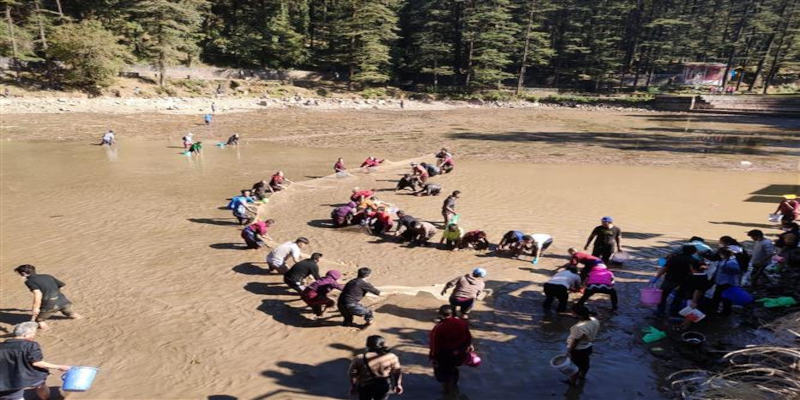26th November: Dharamsala’s Dal Lake has dried up; residents of the Naddi area, as well as a huge number of Tibetans, congregated at the lake to help conserve endangered fish. Local resident Naresh Kumar said that the lake used to be full of water all year. PWD officials, on the other hand, dug up the lakebed with JCB machines a few years ago to deepen it and remove silt. Since then, the lake’s ability to retain water has deteriorated.
Though modest in comparison to its namesake lake in Srinagar (Kashmir), the mid-altitude lake in Tota Rani hamlet, near Naddi, is a natural water source that is crucial for the ecosystem of the surrounding hills. At a height of 1,775 meters above sea level, this natural water body is encircled by Deodar trees and serves as a tourist attraction. However, the lake’s depth has been diminished due to ongoing silting from nearby mountains. Half of the lake’s surface has been filled with silt and turned into grassland.
According to revenue data, the lake covers around 1.22 hectares. Its area, however, has been decreased by half owing to silting. The lake’s depth, which was formerly around 10 feet, has also decreased. The local government had undertaken a big operation to resuscitate the lake in 2011, with the support of citizens who volunteered labor and machines. The silt was removed and utilized to build a parking lot near the temple. Since then, the lake has been rapidly drying up.
According to sources, geologists believe that aqueducts built at the lake’s foundation due to haphazard drilling are causing water to drain. The Kangra district government had enlisted the help of geologists to investigate the reasons behind the lake’s water loss, but no solution had been identified.
In September, a local festival takes place at the lake. The lake is precious to the indigenous Gaddi population, and they want the government to conserve it. Geological specialists have been asked to provide solutions to the problem of the Dal Lake drying up, according to Deputy Commissioner Nipun Jindal.

